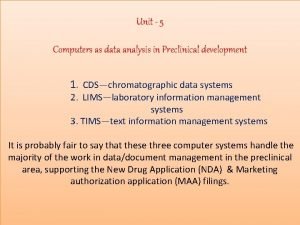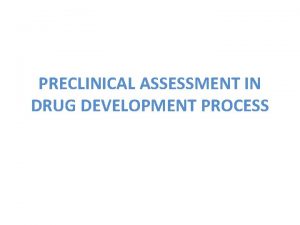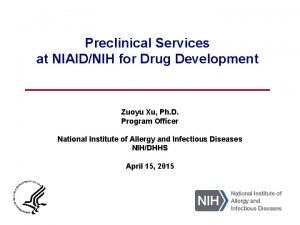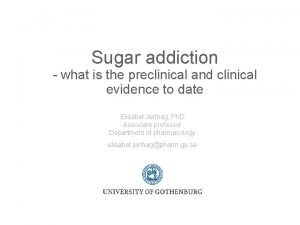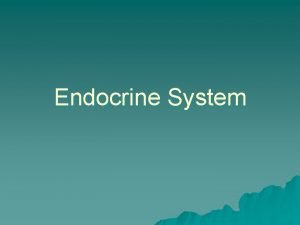An Evaluation of PreClinical Medical Education in Endocrine





- Slides: 5

An Evaluation of Pre-Clinical Medical Education in Endocrine Pathology at a Single Medical School: Gap and Overlap Analysis Denise Elizondo, MS 4 Brody School of Medicine Medical Education and Teaching Scholar Philip J. Boyer, M. D. , Ph. D. Department of Pathology and Laboratory Medicine B R O D Y 7 t h S C H O O L A n n u a l O F M E D I C I N E M e d i c a l D a y E d u c a t i o n

Introduction • The East Carolina University Brody School of Medicine recently underwent a significant reconfiguration of the 2 nd year medical student curriculum with an organ system-based alignment of content. • BSOM’s class of 2021 student average for the “endocrine system” component score of Step 1 was below the national average while the average pathology score was just above the national average. • Objectives: • Define the specific topics that should be taught as part of medical student preclinical instruction in endocrine pathology. • Compare the topics covered in the M 2 pathology course against relevant resources with the goal of identifying any significant gaps in coverage. • Incorporate gaps in material into pathology lectures in January 2022 with the goal of improving endocrine education and pre-clinical endocrine knowledge.

Methods https: //pathology. oit. duke. edu/endocrine/en docrine. html • A “gap and overlap analysis” of the endocrinology content presented in the Pathology thread of the M 2 Endocrine and Reproductive Systems course was undertaken. • Endocrine pathology topics from two standard textbooks (Robbins and Rubin), First Aid for the USMLE Step 1 (2019), USMLE Content Guidelines (2019), and Duke University’s Pathology curriculum were compiled. • Topics covered in each of the above resources were compared to the topics covered in the Pathology thread after compiling them by reviewing Power. Point and Word documents along with recorded lectures. • Pub. Med and Google searches were conducted using key words including endocrine education, medical education, and pathology education. (Amazon. com)

Results • No peer-reviewed articles were identified which specifically summarize or suggest what endocrine pathology topics should optimally be taught during medical school; a British Society for Endocrinology summary of undergraduate medical education curriculum topics was identified. • Over 85 content topics were compiled from combined resources. • Overlaps were found extensively throughout the material, most of which were intentional, to emphasize or interweave topics (e. g. multiple endocrine neoplasia) • 22 gaps were identified in the materials: Table. • 8 of those topics were (1) later covered in Pathology reproductive system lectures or (2) were covered in the Clinical Applications or/and Pharmacology thread lectures. • A total of 14 gaps were identified which were not covered in any thread, mostly minor topics, with the exception of hyperosmolar hyperglycemic state. Lecture 1 - Pituitary Pathology • Galactorrhea not associated with childbirth (USMLE outline) • Laron syndrome (FA) • Prolactinoma and hyperprolactinemia, including infertility (USMLE outline) - Covered in Clinical Applications • Hypogonadism (USMLE outline) --Covered in Clinical Applications Lecture 2 - Thyroid Pathology • Radiation-induced damage to thyroid gland (FA) • Jod-Basedow phenomenon (FA) • Thyroid storm (Multiple resources)-- Covered in Clinical Applications • Infertility due to thyroid disease (USMLE outline) • Silent thyroiditis (Rubin's) • Euthyroid sick syndrome (USMLE outline) Lecture 3 - Adrenal Pathology • Delayed and precocious puberty (USMLE outline)--Covered in Pharmacology and some in Reproduction Lectures 4 & 5 - Endocrine Pancreas Pathology • DKA--Covered in Clinical Applications • Hyperosmolar hyperglycemic state (FA) • DM acute complications--cerebral edema, electrolyte abnormalities, hypoglycemic shock (USMLE outline) • DM chronic complications--gastroparesis (USMLE outline) • DM 1. 5 (USMLE outline) • Glucose homeostasis (Robbins) Lecture 6 - Calcium Metabolism & Parathyroid Pathology • Pseudopseudohypoparathyroidism (FA) Lecture 7 - Syndromes and Multiple Endocrine Neoplasia • No Gaps identified Others in Endocrine Abnormal Processes section of USMLE outline • Disorders of sexual differentiation-- Covered in Reproduction • Androgen insensitivity/resistance syndrome -- Covered in Reproduction • Adverse effects of drug on the endocrine system--Covered some in Pharmacology Robbins and Rubin’s Textbooks • Pineal gland pathology

Conclusions • • This gap and overlap analysis allowed for a systematic review of content covered in the endocrine pathology thread of the M 2 “Endocrine and Reproductive” course. The content covered was very closely aligned with topics covered in the referenced resources. Gaps identified can be added to the pathology material presented in the future. Next Steps: • • Alignment of topics covered in the Pathology thread with topics covered in the Clinical Applications and Pharmacology threads. Comparison of 2019 - 2021 Step 1 endocrine performance average to 2022 average after incorporation of additional topics.

